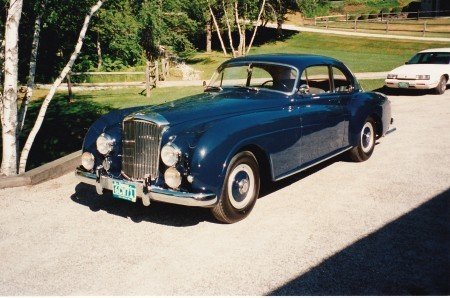R-Type Continental
In 1952, cars that could hit a top speed of 115mph
were uncommon. Cars that could cruise at 100mph with four occupants (and
luggage) were unheard of - until the R Type Continental. Although only
208 were produced, the R Type Continental created a template for Bentley
grand touring that lasted decades. It even inspired the design team
working on the first Continental GT, fifty years later.
Reinventing Bentley
Pre-war, two coachbuilt specials had shown what a
Bentley of the future might be. Both the ‘Embiricos’ Bentley and the
Corniche featured streamlined bodies and were capable of cruising at
high speeds on the fast roads of the continent. One man who took careful
note of these one-off creations was the company’s chief projects
engineer, Ivan Evernden. Although a lifelong Rolls-Royce employee, he
was inspired to reinvent Bentley for the post-war world and distance it
from its more staid cousin.
He was assisted by John Blatchley, chief of the
newly-created styling department at Crewe, who sketched a low, long and
lithe body shape, with its radiator inclined backward from the vertical,
a steeply raked windscreen, rear wheelspats and a fastback roofline.
Fins were added to the rear wings to aid stability at high speed. A
quarter-scale model was made and tested in the company’s aero-engine
division’s tunnel at Hucknall, in Nottinghamshire. Evernden estimated
that air speeds of up to 120mph were attainable. “Much more could have
been done” he wrote in July 1962, “…but the purpose of the exercise was
to reduce the aero drag of a conventional car and not to make a space
capsule for an astronaut.”
Creating the R Type Continental
Using the R Type chassis as a base, Evernden and
Blatchley designed a grand tourer in the Bentley tradition, using
aerodynamics and lightweight construction to create a vehicle capable of
running for long periods at high speed across Continental Europe. It
became an icon of its era; beautifully crafted, fast and exclusive.
Mechanically, the standard 4,566cc, six-cylinder
in-line engine was gently tuned, raising the power from 140 to 153bhp,
with a higher final drive ratio to take advantage of the lighter, more
aerodynamic body.
Coachbuilders H.J Mulliner were tasked with creating
the new, streamlined Bentley coupé. To save weight, the bodywork was
made in aluminium, as were the window frames, the windscreen surround
and the backlight. Even the seat frames and bumpers were aluminium. To
pare weight to a minimum, a radio was considered superfluous.
Weight was the critical factor; tyres that could
carry a two-ton motor car at speeds of over 115mph didn’t exist in 1950.
Evernden calculated that if the new grand tourer were to cruise at
100mph or more, it would have to weigh a maximum of 34 cwt (around 1750
kilograms). Even so, this combination of weight and speed was right on
the limit for the specified Dunlop Medium Distance Track tyres.
All the hard work paid off. In September 1951, at the
Montlhèry track near Paris, the sleek new Bentley averaged 118.75 mph
over five laps, with a best lap speed just under 120mph.
Production approval
Up to this point the prototype - OLG 490, nicknamed
Olga – was a semi-official project. Some on the board of directors felt
it was ‘too sporty’ for a company that also made Rolls-Royce limousines.
But with the help of allies within the company and its overseas
dealerships, Evernden persuaded the board that a market existed for a
coachbuilt Bentley grand tourer. As he had hoped, orders came in from
all over the world, even at the immense price of £6,928 including UK
purchase tax. To put this in context, in 1952 Britain the average annual
salary was £468, and the average house cost £1891.
Many owners specified extras, which had an impact
upon the weight of some models produced during the R Type Continental’s
three years of production. A bigger bore engine with a capacity of
4,887cc maintained the performance, with a practical top speed of around
115mph and easy cruising at 100mph. Later production cars also differed
from ‘Olga’ in having a lower roofline, a one-piece windscreen and
revised wing line.
By the time production ended in 1955, 208 R Type Continentals had been built. All but 15 of them were bodied by H.J. Mulliner.
A modern magic carpet
Accolades followed the launch of the R Type
Continental. The Autocar summed up its appeal; “Whatever memorable
motoring experiences one may have had, this was something different…this
Bentley is a modern magic carpet which annihilates great distances and
delivers the occupants well-nigh as fresh as when they started.”
R Type Continental facts
• Inspired by the pre-war streamlined Embiricos and Corniche one-off coachbuilt Bentleys
• Unofficial project by engineer Ivan Evernden to re-establish Bentley as a maker of high performance cars
• Design created by chief stylist John Blatchley and tested in a wind tunnel
• Built using aluminium to a target weight of 1750kg:
no tyre existed in 1950 which could sustain a heavier weight at 115mph+
• Prototype OLG 490 was created by coachbuilders H.J. Mulliner: became known as ‘Olga’
• At Montlhèry in September 1951 ‘Olga’ averaged
118.75 mph over five laps, with a best lap speed just under 120mph
• Originally offered with a tuned, 4,566cc,
six-cylinder in-line engine producing 153bhp. Later versions 4,887cc
• To save weight, a radio was not fitted as standard
• Total of 208 produced between 1952 and 1955 – 193 were bodied by H.J. Mulliner
• Cost in 1952 was £6,928 including UK purchase tax: almost fifteen times the UK average annual income
• Later production cars featured a lower roofline, a one-piece windscreen and revised wing line
